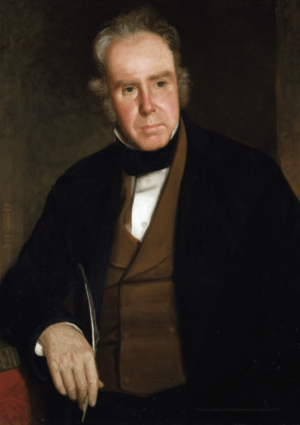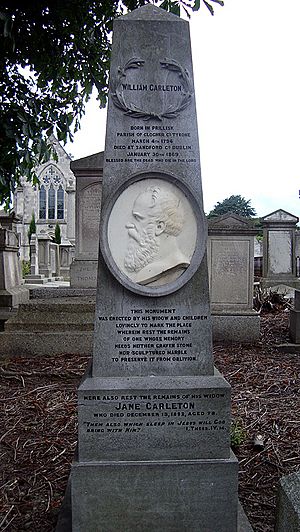William Carleton facts for kids
William Carleton (born March 4, 1794, in Prolusk, Clogher, County Tyrone – died January 30, 1869, in Ranelagh, Dublin) was an Irish writer and novelist. He is most famous for his book Traits and Stories of the Irish Peasantry. This book was a collection of stories that showed different types of Irish people and their lives.
Contents
Early Life and Education
William Carleton grew up in a large family. His father was a farmer who supported fourteen children on a small piece of land. William's early life was very similar to the scenes he later wrote about in his books. His family was full of traditional Irish stories and songs. His father had an amazing memory and knew many old Irish tales. His mother was a great singer in the Irish language.
William received a basic education. As his family moved around, he went to different hedge schools. These were informal schools that were common in Ireland at the time. He wrote about these schools in his story "The Hedge School." Most of his learning came from a priest named Father Keenan. William studied with him from 1814 to 1816.
He hoped to become a priest and even studied for a short time at Maynooth. However, he decided not to join the church. He later wrote about his experiences as a pilgrim in a story called "The Lough Derg Pilgrim." This journey helped him decide not to become a priest, and he eventually became a Protestant.
William Carleton's Writing Career
After deciding against the church, William Carleton wanted to become a writer. He was inspired by a book called Gil Blas. He traveled to Dublin with very little money. He tried different jobs, like stuffing birds, but they didn't work out. He even thought about becoming a soldier!
He eventually found a place to live where he could read many books. He started teaching and working in a Sunday School office. He also began writing for journals. His story "The Pilgrimage to Lough Derg" was published and became very popular.
In 1830, he published his first big book, Traits and Stories of the Irish Peasantry. This book made him famous and is still considered his best work. It included stories like "Phil Purcel The Pig Driver." He published a second series of these stories in 1833 and Tales of Ireland in 1834. He continued to write many books and stories for the rest of his life. One of his novels, "Fardorougha the Miser," appeared in the Dublin University Magazine.
William Carleton wrote many stories about Irish life, especially from the area of south Tyrone where he grew up. He also wrote novels, but his short stories about Irish people are often seen as his best work. He started writing his autobiography, which tells about his life up to the beginning of his writing career. This was later published in a book about his life by David James O'Donoghue. The famous poet William Butler Yeats also wrote an introduction to a selection of Carleton's stories.
In his later years, William Carleton faced financial challenges. Despite writing a lot, he remained poor for a while. However, in 1848, he received a pension of £200 a year. This was given to him by Lord John Russell after many important people in Ireland asked for help on Carleton's behalf.
William Carleton died at his home in Ranelagh, Dublin, in January 1869. He is buried at Mount Jerome Cemetery in Dublin. Even though he had changed his religion, he remained friends with a priest from a nearby church.
His Reputation and Views
William Carleton saw himself as someone who recorded the "habits and manners, their feelings, their prejudices, their superstitions and their crimes" of the Irish people. Some of his later stories, like The Squanders of Castle Squander (1852), included a lot of political ideas.
Controversial Opinions
William Carleton's strong opinions on religion sometimes caused disagreements with other Irish people. He had converted from Catholicism to Protestantism. Some people have suggested that this change might have helped him succeed as a writer in the early 1800s, as it was sometimes easier for Protestant writers to get support.
However, Carleton also wrote letters expressing very strong views against the Catholic Church in Ireland. He believed that some Catholic priests and teachers were causing problems. He even became friends with a Protestant minister who encouraged him to write stories that showed what he saw as issues with the Catholic clergy.
The writer Frank O'Connor believed that Carleton's talent was sometimes affected because he took sides in Ireland's religious disagreements. O'Connor noted that Carleton faced a difficult situation. Protestant readers at the time often wanted stories that showed Catholicism in a bad light. On the other hand, Catholic readers wanted only positive stories about themselves. Because of this, Carleton's writings were often criticized by people who wanted him to write from only one point of view.
Influence on Other Writers
William Carleton is seen as an important writer who came before the Celtic revival. This was a time when Irish writers and artists became very interested in Irish culture and traditions.
He is also mentioned in a long poem called Station Island by the famous Irish poet Séamus Heaney.
Sources



